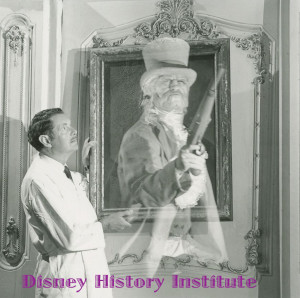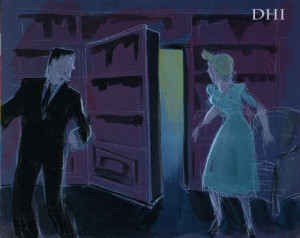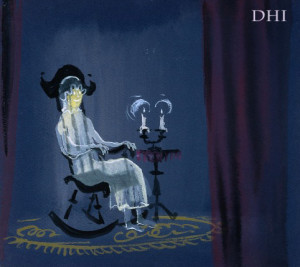The Ghost and Yale Gracey
by Todd James Pierce
[Note: This article is also available as part of the DHI Podcast, Episode 004,
with audio from Disney Legend Rolly Crump. Click HERE. ]
with audio from Disney Legend Rolly Crump. Click HERE. ]
What is the most compelling story about the construction of the Haunted Mansion?
There are, I think, many from which to choose. There’s the story of how Walt Disney once accompanied WED designers to matinee showings of at least one horror movie to “research” concepts for the Haunted Mansion. There’s the story of how these same designers, while creating the ghostly figures, used to rig them so that they would come to life when the cleaning staff entered their offices at night. But my favorite involves a real ghost—one that WED effects master Yale Gracey claimed he saw as a boy.
I know of only one other place where this story was mentioned. And that was only a brief mention. In 1999, WED designer Rolly Crump told a shortened version of this story in a panel discussion for the Mansion’s 30th anniversary. So last year, when I had an opportunity to talk with the amazing Mr. Crump, I asked for a few more details.
Here’s the set up: while Rolly and Yale were developing the effects for the Mansion, Rolly asked: “Have you ever had anything in your life that you thought was kind of supernatural?”
Without hesitation, Yale replied, “Oh yeah, I had a ghost read to me when I was 10 years old.”
Intrigued, Rolly asked Yale to tell the story.
“He and his mother went back to visit relatives on the East Coast,” Rolly explained. “They lived in this big old house. Yale was there for the summer.” During those months, Yale’s mother let him spend time with his cousins. They played inside and outdoors. Each night the children would sleep together in a large bedroom. In this room there was—at least in Yale’s version—an old lady who lived in the closet, a figure who came out from time to time. “She would come out and read to the kids little stories and then she’d go back in the closet.” But the children all understood that they should never talk about the lady to adults lest she disappear for good.
Early Concept Artwork for the Mansion – Ken Anderson
At the end of the summer, Yale’s mother asked what he liked best about their visit. Without hesitation, Yale responded: “The little lady that lives in the closet that reads to us every night.”
The room grew quiet. Yale’s mother, surprised, exclaimed, “What?”
The other children whined, “No, no, Yale, she’ll never come back.”
“Evidentially the mother was concerned about it,” Rolly continued. “And so she went to the local history society and actually found out who the people were that built the original house. And found a picture of that woman who lived there. And went and showed it to the kids.”
That photo, of course, was her, the woman in the closet. Or at least this was the impression that Yale, age 10, had of the image.
Early Concept Artwork for the Mansion – Ken Anderson
At the conclusion of the story, Rolly swore that this was exactly how he heard it from Yale. Moreover, he emphasized that Yale wasn’t one of those people to exaggerate the truth: “Yale would never make anything up. He was about as straight as they came,” Rolly said. “As far as I’m concerned it’s true. It can’t be any truer than that.”
Now I’ll be the first to admit that this story is quite possibly an invention of childhood, a youthful descent into the world of imagined spirits. What child hasn’t at one time looked into a darkened room and seen a ghost? What half-sleeping youngster hasn’t heard a voice originating from elsewhere in a house and imagined it to be somehow inside their bedroom? Regardless, here’s what I love about this story: as an adult, Yale Gracey would be given the task of recreating more-or-less one of his favorite childhood memories. He would invent stage techniques so that ghosts would appear in real space, so spirits would materialize and then disappear into the ether. It’s interesting to contemplate how deeply Yale’s childhood would later give rise to the spectral effects he would create for the Mansion. But that question, of course, is one to which I don’t know the answer. I can, however, offer this: I’ve always felt that the early Mansion in its best rooms did not hold the frights of a horror movie; rather it presented a half pleasurable haunting as seen by children, a cast of translucent ghosts whose primary duty is to tell stories and to entertain.
* * * *
If you’ve enjoyed this story, you can learn more about Rolly’s work with Disney through this link: Rolly Crump
* * * *
NOTES:
* Quotes for this article–including remembered dialogue–come from an interview with Rolly Crump.
* Ken Anderson artwork comes from the collection of Paul F. Anderson, who worked closely with Ken on collecting his memories and work into a full personal history.
* Quotes for this article–including remembered dialogue–come from an interview with Rolly Crump.
* Ken Anderson artwork comes from the collection of Paul F. Anderson, who worked closely with Ken on collecting his memories and work into a full personal history.




Recent Comments